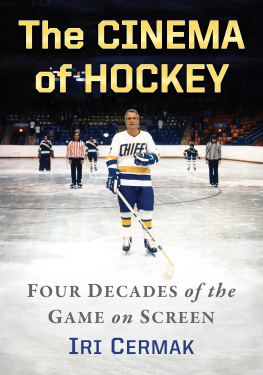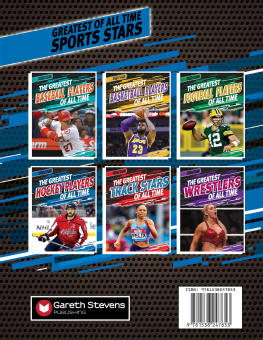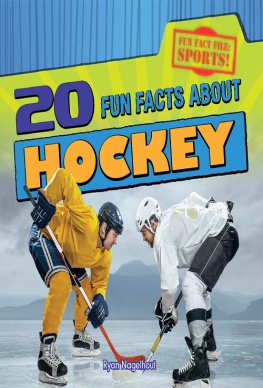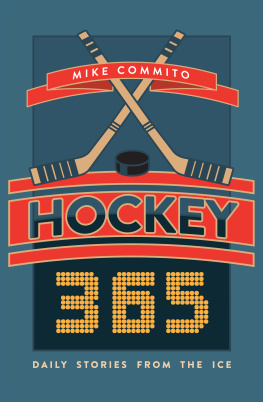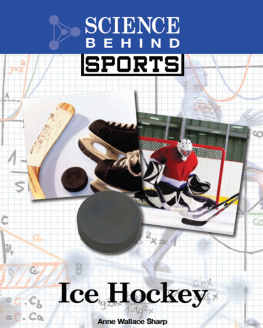
The Cinema of Hockey
Four Decades of the Game on Screen
Iri Cermak

McFarland & Company, Inc., Publishers
Jefferson, North Carolina
LIBRARY OF CONGRESS CATALOGUING DATA ARE AVAILABLE
BRITISH LIBRARY CATALOGUING DATA ARE AVAILABLE
e-ISBN: 978-1-4766-2696-3
2017 Iri Cermak. All rights reserved
No part of this book may be reproduced or transmitted in any form or by any means, electronic or mechanical, including photocopying or recording, or by any information storage and retrieval system, without permission in writing from the publisher.
Front cover: Paul Newman as Reggie Dunlop in the 1977 film Slap Shot (Universal Pictures/Photofest)
McFarland & Company, Inc., Publishers
Box 611, Jefferson, North Carolina 28640
www.mcfarlandpub.com
To the hockey researchers whose work built up the field
and the players who inspired it.
And to my father and grandfather
who passed on to me their love of sport.
Acknowledgments
This project would not have been possible without the help of many individuals who generously shared their research and provided source material as well as encouragement. The author extends appreciation to Amy Ransom for her insightful observations and for generously sharing her work on hockey in Quebec culture. Warm thanks also to Brian Kennedy for going through the manuscript and sending along invaluable comments. Ive had the chance to work with Brian on two separate occasions and the result is always inspiring.
Embarking on a lengthy project like this also entails spending a lot of time hunting down films, and, in this case, there were movies that took many years to obtain. The help of each and every one of these individuals in locating source material was crucial in contributing to the broad range of films in this volume. My heartfelt thanks to: Jean-Patrice Martel of the Society for International Hockey Research (SIHR) who runs the Societys excellent film database and generously referred me to numerous data sources; CBC archivist Roy Harris, who kindly made available two films I would have otherwise been unable to see, and CBC producer Alex Shprintsen for his discussion of Russian hockey and culture, and for his assistance in procuring films; filmmaker and hockey researcher Brett Kashmere, for generously sharing his essay film Valerys Ankle and other creative work; director-writer May Chambers for making available her Lovers in a Dangerous Time; Darren J. Harkness for enabling a viewing of The Hounds of Notre Dame and Evelyn Ellerman for insights that helped me situate the film in proper historical context. Many thanks also to Robert Ligtermoet and to Marco Lienhard both of whom assisted me in locating important source material for chapter seven; and to Rebecca Frank for the heads-up about a film that extended my work on the womens game.
I also wish to thank the following individuals for generously making available a number of movie stills that bring alive the discussions in this book. My deep thanks to Mongrel Medias Hussain Amarshi who kindly made available images from Score: A Hockey Musical, Breakfast with Scot, and Grown Up Movie Star, and Ai Tsuzuki who considerately assisted; Entertainment One and Carrie Wolfe who generously supplied several stills from the popular Goon; Greg Dunning at Cinpix for kindly giving me access to however many stills I needed from the early French-Canadian film, The Mystery of the Million Dollar Hockey Puck; Kevin Tiernan at Park Ex Pictures for coming through on short notice with stellar images of Bon Cop, Bad Cop; Marie Guegan at Films Sville for key referrals; Brenda Carroll for her tireless assistance in obtaining over a dozen images from the CBC archives; Ron Mandelbaum and the Photofest staff for patiently assisting me with my queries and ensuring the best results, and Tricia Gesner for her invaluable help in obtaining Associated Press images.
The following scholars also generously gave me access to their work. My sincere appreciation to: Richard Harrison for his original take on Slap Shot and always stimulating discussions at hockey conferences; Glen Jones for his early essay on the sport film, which proved essential to clarifying my own ideas about the genre; Steve Hardy for his articles and discussions on New England hockey; Stacy Lorenz and Geraint Osbourne for their work on early hockey coverage in Canada; Len Kotylo of the SIHR for sharing his research on Theodore Roosevelts view of the game; Linda Williams who made available her seminal article on the function of the melodramatic mode in Hollywood cinema; Tobias Stark for his inspiring article on Swedish, Soviet, and Canadian hockey; and Peter Dahln for stirring discussions of the game in film early on. I also thank the following individuals and institutions who enabled me to extend the scope of my research: Patricia Hughes-Fuller and James Gifford; Merja Ellefson and Eva Kingsepp, and Nordicom editor Ulla Carlsson; Colleen Coalter, commissioning editor of the Continuum Publishing Company; Loren P.Q. Baybrook, editor-in-chief of Film & History; Blaine Allen, editorial board chair of the Canadian Journal of Film Studies; Marilyn Bittman, managing editor of the Canadian Journal of Communication; author Don Gillmor and the staff at The Walrus; and Felicia F. Campbell of the Popular Culture Review for use of important source material.
Inside the sports industry, I wish to thank the SportsBusiness Journal for allowing me access to the World Congress of Sports conferences held in New York City and Newport Beach, which brought home this research as lived experience. Many thanks also to the Hockey Hall of Fame Archives, in particular, Ron Ellis for his discussion of the 1972 series and the Soviet team, and Tyler Wolosevich for helping me locate important sources. Thank you as well to Hockey Canada and Sean Kelso for lending me a hand with source material on Canadian hockey coverage. My heartfelt appreciation also goes to Teemu Selnne for his insights on Finnish and European hockey, and to the San Jose Sharks organization for facilitating that meeting.
Preface
I first began this work in early 2004 a couple months before Disneys Miracle saw its theatrical release. Eager to start my research at the movie theater, I attended the very first matinee screening. Three older ladies with tickets to another screening caught a glimpse of the Miracle poster and one of them enthusiastically noted that it was the story of the 1980 U.S. Olympic victory over the Soviet team and a must-see. Inside the theater a couple of rows ahead, more than a dozen seven- to eight-year-old boys and girls sat accompanied by two adults. This bit of hockey history would certainly come down to the next generation. At the time, I was in the San Francisco Bay Area where hockey enclaves are not ubiquitous like they are in Canada, and I thought that my research was off to a good start.
Shortly after, and to my great chagrin, I realized that very few of the other hockey-themed films I was aware of were readily available for sale or rent. What of the ones I didnt know about? Sports film anthologies, even Canadian film anthologies, which I hoped would take into account hockeys ranking as a national sport, listed at best one or two films. In contrast, sports collections featured much greater numbers of boxing, baseball, and football entries.
Next page
